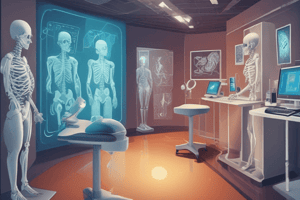Podcast
Questions and Answers
Why is barium sulfate considered a suitable contrast agent for examining the gastrointestinal tract?
Why is barium sulfate considered a suitable contrast agent for examining the gastrointestinal tract?
Barium sulfate is nontoxic, has a relatively high density, and attenuates X-rays well.
How is a double-contrast study conducted with barium sulfate?
How is a double-contrast study conducted with barium sulfate?
Air is added to the barium sulfate suspension by ingesting fizzy granules or directly instilling air.
What are the main reasons iodine-based molecules are suitable for use as contrast agents?
What are the main reasons iodine-based molecules are suitable for use as contrast agents?
Iodine has a high atomic mass, markedly attenuates X-rays, and is naturally excreted via the urinary system.
What precautionary steps must be taken when using intra-arterial or intravenous contrast agents?
What precautionary steps must be taken when using intra-arterial or intravenous contrast agents?
Describe the process of subtraction angiography.
Describe the process of subtraction angiography.
How has digital imaging impacted the technique of subtraction angiography?
How has digital imaging impacted the technique of subtraction angiography?
What additional applications come from using intravenous contrast agents in medical imaging?
What additional applications come from using intravenous contrast agents in medical imaging?
What is the primary benefit of using a double-contrast (air/barium) study in gastrointestinal examinations?
What is the primary benefit of using a double-contrast (air/barium) study in gastrointestinal examinations?
Flashcards
Why is barium sulfate used in X-ray imaging?
Why is barium sulfate used in X-ray imaging?
Barium sulfate is a contrast agent in X-ray imaging, as it is nontoxic, has a high density, and readily absorbs X-rays.
How is a double-contrast study using barium sulfate performed?
How is a double-contrast study using barium sulfate performed?
Air is introduced into the barium suspension to enhance visualization, achieved by ingesting fizzy granules or directly introducing air.
Why are iodine-based contrast agents used in medical imaging?
Why are iodine-based contrast agents used in medical imaging?
Iodine's high atomic mass, strong X-ray absorption, and natural excretion through the urinary system make it a suitable contrast agent.
What are the precautions for using intra-arterial or intravenous contrast agents?
What are the precautions for using intra-arterial or intravenous contrast agents?
Signup and view all the flashcards
How does subtraction angiography work?
How does subtraction angiography work?
Signup and view all the flashcards
How has digital imaging impacted subtraction angiography?
How has digital imaging impacted subtraction angiography?
Signup and view all the flashcards
Besides blood vessels, what else can intravenous contrast agents visualize?
Besides blood vessels, what else can intravenous contrast agents visualize?
Signup and view all the flashcards
What is the benefit of using a double-contrast study in gastrointestinal examinations?
What is the benefit of using a double-contrast study in gastrointestinal examinations?
Signup and view all the flashcards
Study Notes
Contrast Agents
- Barium sulfate is a non-toxic, high-density contrast agent used to examine the gastrointestinal tract, particularly the bowel lumen, as it attenuates X-rays.
- Barium sulfate suspension is ingested and can be mixed with air, known as a double-contrast (air/barium) study, to enhance visualization of the bowel lumen.
- Iodine-based molecules are used as contrast agents for intra-arterial and intravenous injection, as iodine has a high atomic mass and markedly attenuates X-rays, and is naturally excreted via the urinary system.
Safety and Precautions
- Iodine-based contrast agents are generally safe and well-tolerated, but rare anaphylactic reactions can occur, requiring necessary precautions.
Subtraction Angiography
- Subtraction angiography is a technique used to enhance visualization of contrast agents in vessels by subtracting images taken before and after contrast injection.
- The process involves:
- Taking one or two images before injecting contrast media
- Inverting these images to create a "negative" image
- Taking further images after injecting contrast media
- Adding the "negative precontrast image" to the positive postcontrast images to subtract bones and soft tissues, leaving only the contrast image.
Applications
- Intra-arterial and intravenous contrast agents can visualize arteries, veins, kidneys, ureter, and bladder through intravenous urography.
- Subtraction angiography can produce high-quality images of blood vessels and surrounding structures.
Studying That Suits You
Use AI to generate personalized quizzes and flashcards to suit your learning preferences.




